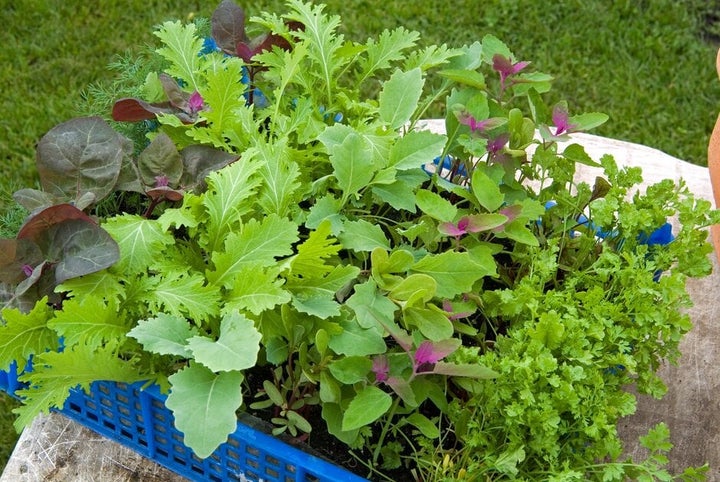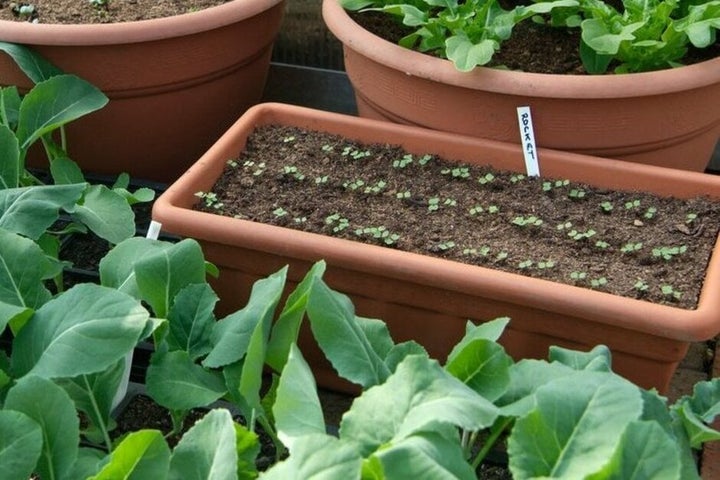Getting Started
More colourful, diverse and tasty than pre-packed supermarket offerings, home-grown salad leaves are quick and easy to grow. As well as an array of lettuce varieties, you can grow all manner of other tasty leaves to pick when young and tender, including mizuna, rocket and mustard. They take up little space and can be picked repeatedly, for delicious salads across the seasons.

Grown as cut-and-come-again crops, you can just snip a few leaves from each plant and more will grow. Sow the seeds indoors or outside and you can be eating your home-grown salad leaves in as little as four weeks in summer or around eight weeks in cooler weather.
These crops will all grow happily in containers, from patio pots to windowboxes, or in any sunny patch of ground, whether on the veg plot or along the front of a flower border – wherever you have a little spare space. Just make sure they’re close at hand for easy, fresh pickings whenever you need them.
Jobs to do now
Harvest
Month by Month
Sow
Harvest
Choosing What To Grow
Salad leaves can include a whole range of leafy crops, to bring an exciting mix of flavours, textures and colours to your salads. The most obvious starting point is loose-leaf lettuces, of which there are many varieties. Then you can choose from a huge selection of other leaves ideal for growing as cut-and-come-again salads, including peppery rocket and American cress, mild-tasting lamb’s lettuce (or cornsalad), young spinach, chardand kale, oriental greens such as mizuna, mibuna and pak choi, spicy mustards, tangy endive and chicory, and zingy herbs such as coriander and sorrel.
You can buy seeds of these crops individually or choose from a wide range of seed mixes. These allow you to try various different leaves without buying lots of packets. Some mixes are for specific seasons or year-round sowing, for certain growing locations or speedier harvests, for decorative appeal with coloured or frilly leaves, or for spicy or mild flavour combinations.

When choosing salad seeds, look in particular for varieties with an RHS Award of Garden Merit (AGM), which shows they performed well in trials, so should grow well. See our list of AGM fruit and veg (135kB pdf) for varieties of loose-leaf lettuces, chard, chicory, endives and spinach, and also our Recommended Varieties below. For more veg-growing inspiration, visit any of the RHS gardens, as they grow a wide range of salads and other quick and easy crops.
What & where to buy
Seeds are widely available from most gardening retailers all year round, either as individual varieties or salad-leaf mixes. You may also find online or in garden centres in spring and early summer, although the choice may be rather limited.
Recommended Varieties

Cornsalad 'Cavallo'
Cornsalad or lamb's lettuce – this hardy variety forms compact rosettes of spoon-shaped leaves.

Chard 'Bright Yellow' AGM
Chard – a striking variety with green leaves and yellow stems. Young leaves add colour to salads.

Lettuce 'Navara' AGM
Lettuce – oak-leaf variety with glossy, dark-red leaves that are green in the centre.
Preparing The Ground
Choose a sunny growing site, ideally with fertile, moisture-retentive soil. Remove any weeds and fork in about two bucketfuls of garden compost per square metre/yard to help hold moisture in the soil. Firm the ground gently then rake the surface until fine and level, removing any large stones. Alternatively, if you're practising no-dig, the ground ahead of sowing or planting directly into the mulch.
Sowing
Salad leaves are easy to grow from seed and can be sown in the ground or in containers from spring through to autumn. They take up very little space, so are an ideal crop for small gardens, balconies and even windowsills. Many have decorative leaves and look great at the front of flower borders and in patio containers.
They are also useful for sowing in any short-term gaps in your veg plot, borders or containers. You can sow them among slow-growing crops such as parsnips and potatoes, to make good use of limited space, as they will be harvested before the main crop needs the room.
For plentiful harvests all summer long, sow small batches every few weeks – once one batch is finished, the next one will be ready to start harvesting. You should get two or three pickings from each sowing.

Sowing indoors
Sow salad leaves indoors from February onwards in small pots, seedtrays or modular trays filled with moist, peat-free . Scatter the seeds thinly and add a light covering of fine . Place in a warm, bright location such as a windowsill or in a .
should appear in only a few days. Once they have at least a few leaves and are robust enough to handle, move them into individual /pots. Then, after a few more weeks, once they’re growing strongly, move the young plants outdoors, from spring to late summer, into containers or the ground – see Planting, below.
Indoor sowing is particularly useful to get a head start in spring, before it’s warm enough to sow outdoors, or in autumn, once it’s too cold for seeds to germinate in the ground. Autumn-sown salads can be kept in a greenhouse or on a sunny windowsill over winter, or in mild regions hardy varieties can be kept under cloches or in a coldframe.
Sowing outdoors
You can sow salad leaves outdoors from mid-spring through to late summer. Prepare the ground as above, then sow into short drills, about 1cm (½in) deep and 30cm (12in) apart, or scatter the seeds over a small area and cover lightly with soil. Sow a small batch of salad seeds every few weeks to provide non-stop harvests. For more sowing tips, see our guides below.
Salad leaves can also be grown in all types of containers, from patio pots to windowboxes, hanging baskets to growing bags. Larger containers are preferable – at least 30cm (1ft) wide – as the potting will dry out less quickly than in small ones. Fill with peat-free seed compost or peat-free multi-purpose compost, firm gently and water thoroughly before sowing. Sow the seeds thinly, at a depth of 1cm (½in).
Seeds should germinate in just a few days, especially in warm weather. As the grow, thin out a few to prevent overcrowding – check seed packets for recommended spacings. This will give the remaining plants more room to develop, and you can use the thinnings as baby leaves in salads. Be sure to protect seedlings from slugs and snails, especially in damp weather.

Planting
Young salad plants grown from seed indoors or bought as can be planted outside from spring onwards, once they’re about 10cm (4in) tall. Prepare the plants for outdoor conditions by hardening off, so they don’t suffer a check in growth. Plant into prepared ground (see above) or into a large container, at least 30cm (1ft) wide and deep, filled with peat-free multi-purpose .
Space the plants 10–15cm (4–6in) apart, depending on the variety – check seed packets or plant labels for details. In spring, protect plants from cold by covering with cloches or plastic-free fleece. In hot weather, young transplants can quickly wilt, so plant them in a cooler, lightly shaded spot, which should also deter bolting (flowering prematurely), and water regularly.
Autumn-sown salads can be planted in a greenhouse border to crop over winter, or in mild regions hardy varieties can be grown under cloches or in a coldframe.
Plant Care
Salad leaves need little maintenance, apart from ongoing protection from slugs and snails, and regular watering to prevent drying out.
Watering
Water salad and young plants regularly until well established. Young plants can quickly wilt and die in hot, dry weather, and it can also trigger bolting in some salad crops. Plants in containers are particularly vulnerable, as the can dry out rapidly, so check them regularly – they may need watering daily in summer.
The best time to water is early in the morning, so the plants don’t dry out during the day and can grow steadily. Avoid watering in the evening if possible, as damp conditions overnight can attract slugs and snails or contribute to fungal problems such as grey mould.
Feeding
Salad plants don’t usually need feeding, as they are a short-term crop and should grow well in most soils or potting composts.
Weeding
Keep the area free of weeds, so young salad don’t get overwhelmed by vigorous weeds or have to compete for water or sunlight. Dense weeds can also provide hiding places for slugs and snails, and reduce air circulation, which can encourage fungal diseases such as grey mould.
Bolting
Flowering – or – makes the leaves of lettuces and some other salad-leaf crops turn bitter and inedible. After flowering and seeding, annual salad plants will die – this is inevitable, but can sometimes be delayed by removing the flower stems as soon as they appear.
Hot, dry weather will often trigger premature flowering, so take care to water regularly in summer. During the hotter months, sow in light shade to keep plants cooler. When growing in containers in summer, move them out of the midday sun if possible and water regularly, as potting can dry out rapidly.
Harvesting

Salad leaves can be ready to harvest almost all year round if you sow small batches regularly and choose suitable varieties for colder weather. Over winter, protect plants with cloches or plastic-free fleece, or grow in a coldframeor greenhouse.
Start harvesting the leaves when the plants are about 10cm (4in) high, which can be just a month or so after sowing during summer or a couple of months in cooler weather. Snip off a few of the outer leaves with scissors, and more will grow from the centre, which will be ready to harvest a few weeks later. Alternatively, with plants such as loose-leaf lettuces, you can cut all the top growth, leaving a stump 2.5cm (1in) high, which should re-sprout fresh leaves.
With plants such as chard and kale, the leaves will eventually get too large and coarse to eat raw as salad, but are still delicious as cooked greens. With most other salad leaves, the plants will eventually flower, and are then no longer any good for harvesting, so simply replace them with fresh plants once this happens.
Problem Solving
Not surprisingly, soft, juicy salad leaves are a tasty snack for many garden creatures. Principal among these are slugs and snails, but aphids, root aphids, cutwormsand even birds can cause problems. A protective covering of plastic-free fleeceor insect-proof mesh can deter the latter three. In damp, humid weather, grey mould may affect some salad leaves. Remove any faded leaves promptly and space plants widely to improve air circulation. In hot, dry weather, some salad plants, especially lettuces, may start flowering ( ), which turns the leaves bitter. So keep plants well watered, apply and sow in light shade in summer. For more on these and other issues, see Common problems, below.
Common Problems

Bolting in vegetables
Bolting is the term applied to vegetable crops when they prematurely run to seed, usually making them unusable. A cold spell or changes in day length...

Brassica downy mildew
Downy mildew of brassicas is a foliar disease causing whitish, fuzzy patches on the undersides of leaves and yellow discolouration on the top. It affe...













